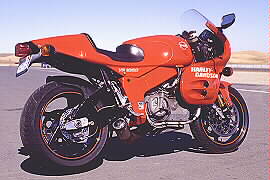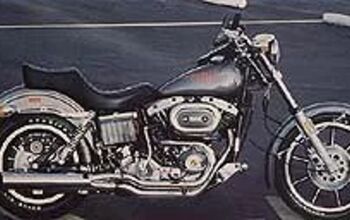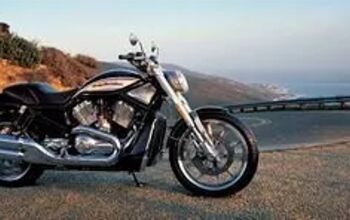Church of MO: 1996 Harley-Davidson VR1000
And in those days before the Crash, and before many Boomers had reached the big four-oh and grown stomachs that make it difficult to bend over, how popular were sportbikes? They were so popular Harley-Davidson built its own roadracer. Now that there are rumors from the east that another purpose-built H-D racer may soon be on the way, it is only fitting that we dredge up the VR1000. Ashes to ashes, dust to dust.
———————————————————————————————————
Track Test: Harley Davidson VR1000
With a thoughtfully deliberate nudge (because the transmission selects gears exactly opposite the normal way) the gear lever clicked into third, and the needle flicked quickly up from 8,000 rpm again. Another nudge into fourth, then fifth, and turn one arrived, hard. Time for a two-fingered squeeze on the oh-so-strong brakes, and time to lean to the left, hard.
This is definitely not your average Harley-Davidson, or even one that shares any parts with the usual Milwaukee iron. The VR1000 is a V-twin, it’s made in America, but there the resemblance ends. This half orange, half black apparition is built solely for the racetrack: Any resemblance with any other form of Harley-Davidson motorcycles begins and ends with the name on the fairing.
Made in America was the theme for the Harley factory’s first built-from-scratch roadracer, the VR1000. Harley’s road-racing department put the bike together using a list of American parts suppliers, some with no motorcycle experience, using no existing Harley motorcycle parts.
The streetable VR1000 you see here (and the race version) are both owned by Mike Canepa, manager of the San Jose Harley-Davidson race team. Over the latter part of the 1995 season, Mike has spent hours in his shop, and in the shops of many other Northern California metalwork magicians, fettling the VR to its peak performance. Their work all seemed worthwhile when rider Michael Barnes qualified faster than the factory riders, Doug Chandler and Chris Carr, at the Phoenix AMA national at season’s end. Canepa owns the street VR as a rolling parts cache for the race bike, but offered Motorcycle Online a chance to ride the rare machine. We jumped at it.
The VR is an unabashed racer, hiding behind its faired-in single headlamp, elephant-ears mirrors and unlikely turn signals. But it’s a racer without a pedigree. Unlike the Japanese and Italian competition, the VR doesn’t have decades of race experience behind it. A glance from the left side of the VR1000 will give a clue to why Harley did things this way — the engine looks like one fourth of a V-8 car engine, and the car world has many collective years of making rapid motors. How difficult could it be to make a fast V-twin and stuff it into a well-handling chassis? The answer is, very. Two seasons later, the America First policy has changed. The sturdy, strong-as-the-Golden-Gate-Bridge frame with its direct connection between steering head and adjustable swinging arm remains, but many other components have been changed, and it’s likely that more will change before the VR shows up for the first race of the ’96 season.
Ohlins front fork tubes now grace the front end, and wheels are now lighter-than-the-originals Marchesini items. Two years of racetrack development have obviously brought refinement, but the search for more power has continued.
The 60 degree V-twin (previous Harleys have all shared a narrower, 45 degree angle between the cylinders) is less tall than a narrower angle v-twin would be, yet doesn’t present the design difficulties that a long, 90 degree V-twin (like all the current two-cylinder Ducatis) would to a frame designer. The engine is compact, and fits well between the twin spars of the massive box-section aluminum frame. Popular mythology around the race track attributes that strong frame with unshakable handling, but the experience of various riders has been different, according to trackside sources.Over the last two seasons, the VR’s obvious power disadvantage has kept it off the podium, but the factory team has also struggled with handling problems. Factory rider Doug Chandler complains of understeer on corner exits, of too much weight up high.
Perhaps the frame design will change, (Over? Spondon? Harris?) but this year time was spent chasing other, more immediate problems. The original factory triple clamps presented a very narrow bearing area to the frame, and one of the factory improvements this year has been to change the clamps, and the bearings, to offer more support. Both San Jose Harley VRs are fitted with Fast By Ferracci magnesium triple clamps. The bigger clamp pinches the Ohlins tubes less, one theory being that misalignment of the tubes was upsetting handling. But the non-adjustable clamps also have a more solid bearing surface than the Harley originals, and according to Canepa, riders who have ridden the bike since the change have all noticed the difference.
First impressions are of heft, due to the large gas tank right in front of the rider’s perch, and of the massive size of all components. The magnesium triple clamps are huge, and a giant economy size piece of carbon fiber covers the fairing mounted battery and regulator.
It would have been nice to sample an absolutely stock VR, but as I rode the VR1000 around Northern California’s Thunderhill track, it felt good just to be riding one at all. To be legal for AMA Superbike races, the VR must be street legal. Not in the US, but street legal somewhere in the world. It would cost Harley a fortune to make the VR street legal in emissions-conscious America, so a country of convenience was chosen. Next time you go to Warsaw, have a look in the Harley dealer’s window, let me know if they’ve sold their VR yet. Yes, the VR is officially legal for street use only in Poland. You’ll have to go there to buy one, unless the factory relents and does the US paperwork, or unless you promise them you’ll use the bike only on the racetrack: And then do it. Harley has some pretty hefty lawyer friends…
First impressions are of heft, due to the large gas tank right in front of the rider’s perch, and of the massive size of all components. The magnesium triple clamps are huge, and a giant economy size piece of carbon fiber covers the fairing mounted battery and regulator.
My first laps around Thunderhill are timid, slow affairs, as I get used to the bike; the feel of its brakes, the quirks of handling. The steering damper imparts a vague feel to the steering, so I back it off to almost nothing. The Ohlins forks are supple, blanking out all tiny bumps in this smooth track. The rear suspension felt stiff, overdamped when I first bounced on the seat, but it handles the real-world cornering loads with aplomb, soaking up the bumps. It’s only when I open the throttle, hard, over the curb at the apex of turn nine that the front wheel rears, shakes its head, then settles back. It doesn’t misbehave, but the bike doesn’t inspire instant confidence. This machine must be muscled into turns, but once it does comply, the combination of 17 inch front wheel and ultra-quick steering head angle flick almost too quickly. The brakes, though, are a delight. The six-piston calipers bite progressively, hard as you want, and bring the machine down to slow speed, quick. After a dozen laps, I’m beginning to get a handle on the bike’s manners, and able to heel it into turns easily, but the $50,000 price tag is hard to forget.Now it’s time for the VR racer, and the difference between the two is amazing. Fifty pounds lighter, thanks to the lack of battery, lights, and electric starter, the racer pulls better from low rpm, handles more predictably (helped by brand new racing slicks and a quarter inch wider front wheel), and I’m instantly circulating faster. The gearing is just right for the track, and in the hands of a real racer, the bike would easily pull up to the 10,800 rpm redline at the end of the straight. In my hands, the tach needle climbs to oh-so-nearly to brush the ten thou’ marker.
I’m impressed with how near to the mark the Harley is — and how far the VR has got to go. If it can’t scare me, it needs more power, less weight. Canepa and the San Jose team have made steps towards more power — most noticeably with head work performed by Santa Rosa, CA based Engine Dynamics — but there’s sure to be a lot of head-scratching in Milwaukee this winter, and more than one engineer trying to make the orange and black beast faster.
More by John Burns
































Comments
Join the conversation
The VR is a curious case of a successful company trying something different (for them) and then not really committing, then wondering why it didn't work out. They certainly had at least one good rider per year: Duhamel, Russell, Chandler, Carr, Wilson. So they at least got that part right.
The bike's basic architecture was defined in the late 80's, then languished undeveloped for a few years: so already starting out behind. Imagine the VR1000 in say, 1988 rather than 1994. It could have been a different story. In hindsight the project was doomed from the start as the racing world had moved on from when it was conceived. Imagine lining up in 1996, in AMA Superbike (the premier national series in the world at the time, equivalent to BSB today), and not even having six gears. Yes the VR got by with a 5-speed for the first few years of it racing life. Ridiculous.
With all that said, a real production machine would have been a very cool streetbike. Black on one side and orange on the other (including the frame paint!). Unique color scheme for sure.
There are a couple of nice VR1000's hanging out at Barber Motorsports Museum. In the flesh they are purposeful good looking motorcycles. I've seen a few for sale and all going well north of $60k.